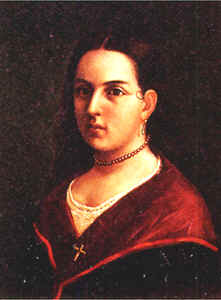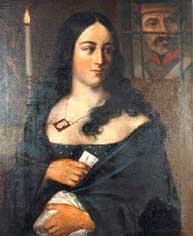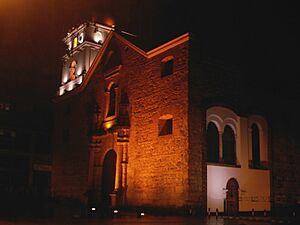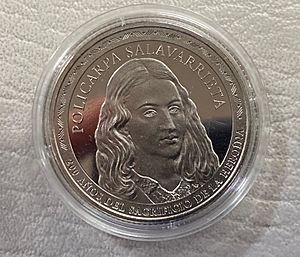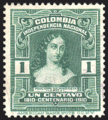Policarpa Salavarrieta facts for kids
Quick facts for kids
Policarpa Salavarrieta
|
|
|---|---|

Heroine of the Colombian Independence Movement
|
|
| Born | 26 January 1795 |
| Died | 14 November 1817 (aged 22) |
| Resting place | Church of San Agustín, La Candelaria, Bogotá, D.C., Colombia |
| Nationality | Neogranadine, Colombian |
| Occupation | Seamstress and spy |
| Parent(s) | Joaquín Salavarrieta Mariana de Ríos |
Policarpa Salavarrieta (born around 26 January 1795 – died 14 November 1817), often called La Pola, was a brave young woman from New Granada (now Colombia). She worked as a seamstress but secretly acted as a spy for the groups fighting for independence from Spain.
During a time when Spain was trying to take back control of New Granada, Policarpa gathered important information for the freedom fighters. She was caught by the Spanish forces and was sadly executed. Today, she is remembered as a great heroine of Colombia's independence. The "Day of the Colombian Woman" is celebrated every year on the date of her death.
Contents
What Was Her Real Name?
Policarpa's exact birth name is not fully known because her birth certificate was never found. The name Salavarrieta comes from her family and friends. Her father called her Apolonia in his will.
She was very close to her brother, Bibiano. After their parents passed away, she became like a guardian to him. When the Spanish forces started looking for her in Guaduas, she began using the name Policarpa.
Later, she used a fake passport to travel in and out of Bogotá. On this passport, she was called "Gregoria Apolinaria." People she worked with and a rebel leader also used this name for her. However, most people knew her simply as "La Pola." This is the name she is best remembered by today.
Where and When Was Policarpa Born?
Just like her name, Policarpa's exact birthday and birthplace are not certain. Many people believe she was born in the town of Guaduas, Cundinamarca, sometime between 1790 and 1796. Some historians thought she was born in other cities like Mariquita or Bogotá.
Historians have looked at records of her brothers and sisters to guess her birth details. Her siblings were:
- María Ignacia Clara (1789–1802)
- José María de los Ángeles (born 1790)
- Catarina (born 1791)
- Eduardo (1792–1802)
- Manuel (born 1796)
- Francisco Antonio (born 1798)
- Ramón (born 1800)
- Bibiano (born 1801)
Based on these records, it seems Policarpa was born between 1791 and 1796. The family likely lived in Guaduas and then moved to Bogotá after Manuel was born in 1796. In 1991, the Colombian Academy of History officially decided that Guaduas was her birthplace.
Policarpa's Early Life
Even though Policarpa's family wasn't rich or famous, they were respected. Their childhood home in Guaduas is now a museum. The Salavarrieta Ríos family moved to Bogotá between 1796 and 1798.
In 1802, a terrible smallpox sickness spread in Bogotá. It killed thousands of people, including Policarpa's father, mother, brother Eduardo, and sister María Ignacia. After this tragedy, the family split up. Her brothers José María and Manuel became monks. Ramón and Francisco Antonio went to Tena to work on a farm.
Catarina, her oldest surviving sister, moved back to Guaduas around 1804. She took Policarpa and Bibiano with her. They lived with their godmother and aunt for a while. Then, Catarina married Domingo García, and Policarpa and Bibiano moved in with them.
We don't know much about Policarpa's life during this time. We do know she worked as a seamstress. She might have also been a teacher in a public school.
Guaduas was a very important stop on the main road in New Granada. Many different people passed through, including soldiers, traders, and rebels. This made Guaduas a place where lots of news and information was shared. During the war for independence, Policarpa's family was involved with the rebels. Her brother-in-law, Domingo García, died fighting for freedom. Her brother Bibiano also fought in the war.
Policarpa Becomes a Revolutionary
Before 1810, Policarpa wasn't involved in politics. But by 1817, when she moved back to Bogotá, she was actively helping the independence movement. Bogotá was a difficult city to enter or leave because it was controlled by the Spanish. Policarpa and her brother Bibiano used fake documents to get into the city. They had a letter introducing them to Andrea Ricaurte y Lozano. They pretended to be her servants, but Andrea Ricaurte's home was actually a secret meeting place for spies and rebels.
In Guaduas, Policarpa was known as a rebel. But in Bogotá, she was unknown, which helped her move around freely. She could meet with other patriots and spies without being suspected. She also managed to get into the homes of Spanish loyalists.
Policarpa offered her services as a seamstress to the wives and daughters of Spanish officers. While she worked, she would listen to their conversations. She gathered information about their plans, found out who the main loyalists were, and learned who was suspected of being a rebel. She also visited rebels in prison, bringing them food and telling them about the independence efforts. She even kept track of loyal patriots, noting who joined the army or donated money to the cause.
Policarpa also secretly helped recruit young men to join the rebel army. With her brother's help, they increased the number of soldiers fighting for freedom in Cundinamarca.
Policarpa's Capture
Policarpa knew that she might be caught soon. She warned her fellow rebels to destroy any papers that could link them to the independence movement. Many documents had the names of patriots, and Policarpa wanted to keep them out of Spanish hands.
Her spy work went well until the Almeyda brothers were caught. They were carrying information back to the rebels outside Bogotá. Their capture directly linked Policarpa to the independence movement. The Almeyda brothers and Policarpa were accused of helping soldiers leave the Spanish army to join the rebels. They were also accused of moving weapons and supplies, and helping the Almeydas escape from prison earlier.
The Spanish now suspected Policarpa of being a traitor, but they didn't have strong proof against a simple seamstress. However, the arrest of Alejo Sabaraín changed everything. He was caught trying to escape with a list of loyalists and patriots that Policarpa had given him.
Sergeant Iglesias, a main Spanish officer, was ordered to find and arrest her. Policarpa Salavarrieta and her brother Bibiano were arrested at Andrea Ricaurte y Lozano's house. They were taken to the Colegio Mayor de Nuestra Señora del Rosario, which was being used as a prison.
Trial and Execution
Policarpa and her brother were brought before a military court. She was found guilty of working against the Spanish Crown. On November 10, Policarpa, Alejo Sabaraín, and six other prisoners were sentenced to be executed by a firing squad. The execution was set for the morning of November 14, 1817.
At nine in the morning on November 14, Policarpa's hands were tied. She walked to her execution with two priests by her side and a guard leading the way. Instead of repeating the prayers, she bravely spoke out against the Spanish. She predicted that they would be defeated in the coming revolution.
It is said that Policarpa cursed the Spanish all night before her execution. At one point, she stopped, tired and thirsty. A guard offered her a glass of wine. She threw the glass back at her captors, saying, "I would not accept even a glass of water from my enemies!"
She was to die with six other prisoners and Alejo Sabaraín, her loved one, in Bolívar Square. When she reached the platform, she was told to turn her back, as that was how traitors were killed. But Policarpa refused. As she was led to her death, she encouraged the other prisoners and scolded her captors. She bravely faced the Spanish firing squad and shouted in Spanish:
Vile soldiers, turn your arms against the enemies of your homeland, lazy people! How different your fate would be today if you knew the price of liberty! But it is not too late: see that - though [I am] a woman and young - I have courage enough to suffer death and a thousand other deaths more. Do not forget this example [...] Wretched people, I pity you. Someday you will have more dignity! [...] I die to defend the rights of my homeland. -Policarpa Salavarrieta
When the soldiers began shooting, Pola turned to face them and was killed.
Usually, the bodies of those executed were paraded through the streets to scare others. But because Policarpa was a woman, she was spared this final humiliation. Her brothers, José Maria de Los Ángeles and Manuel Salavarrieta, who were monks, claimed her body. They gave her a proper burial in the church of San Agustín in La Candelaria.
Policarpa's Legacy
Historical Importance
Many historians believe Policarpa Salavarrieta is the most famous woman of the Colombian War of Independence. Her execution, as a young woman for a political crime, deeply affected the people. It made many more people angry at the Spanish rule and increased support for the rebels. While many women were killed during the Spanish occupation, Policarpa's story truly captured the hearts of the people. Her death as a hero has inspired poets, writers, and artists to tell her story, always highlighting her bravery.
Remembering Policarpa in Colombia
- The town of Policarpa, Nariño is named after her.
- A neighborhood in Bogotá and a TransMilenio station are named after her.
- There are also neighborhoods named "La Pola" in Medellín and Ibagué.
- A park in La Plata, Huila and a school in Monteria are named in her honor.
- There is a monument of Policarpa Salavarrieta in Chiquinquirá.
Day of the Colombian Woman
On November 8, 1967, the Colombian government passed a law. This law declared that November 14 would be the "Day of the Colombian Woman." This day honors Policarpa Salavarrieta and marks the anniversary of her death.
Policarpa on Colombian Money
Policarpa Salavarrieta has appeared on Colombian currency many times. For a long time, her portrait was the only one of a real woman (not a made-up figure). Until 2016, her image was on the 10,000 peso note, with her birthplace on the other side.
Postage Stamps
To celebrate 100 years of Colombian independence in 1910, the government issued a series of stamps. These stamps featured images of independence heroes, including Policarpa Salavarrieta, Simón Bolívar, and others.
Named After Her
A new type of tarantula found in Colombia, called Pamphobeteus lapola, was named after Policarpa Salavarrieta in 2022.
See also
 In Spanish: Policarpa Salavarrieta para niños
In Spanish: Policarpa Salavarrieta para niños
- Cola & Pola, a Colombian drink named after Policarpa


